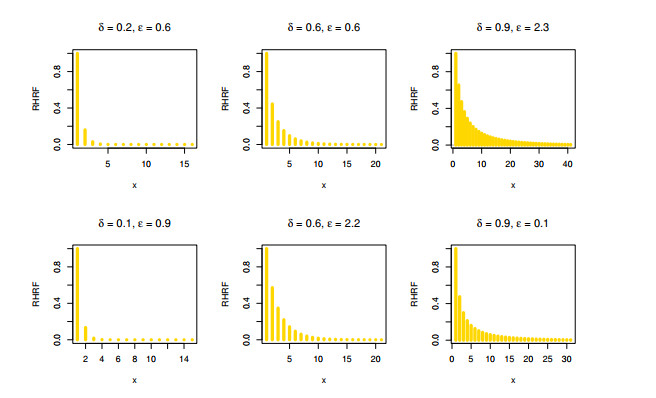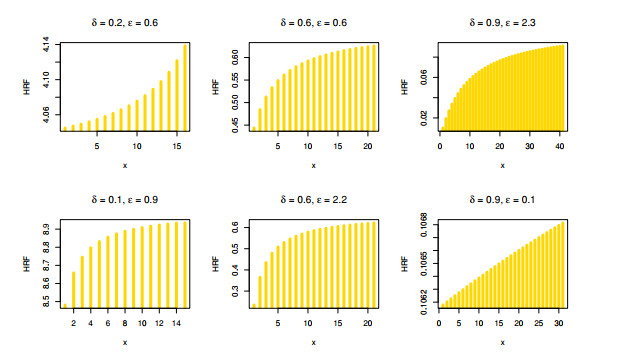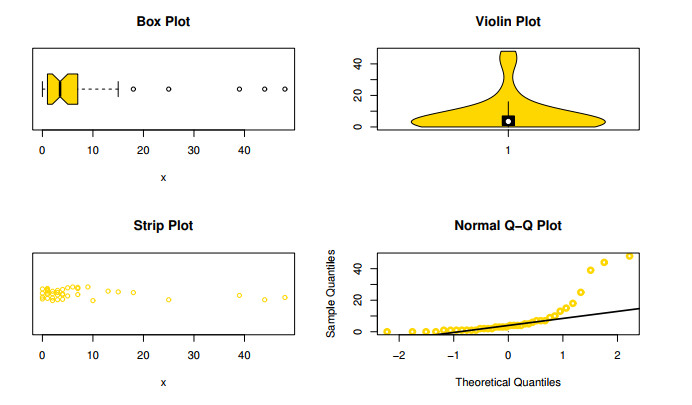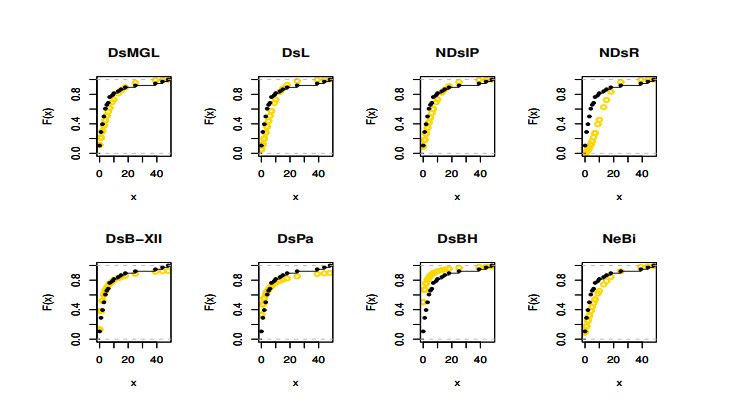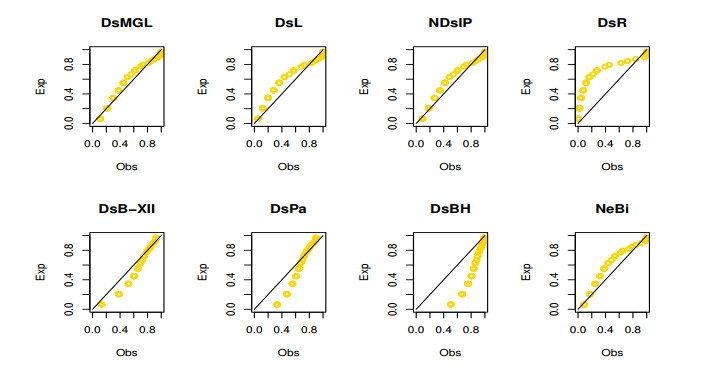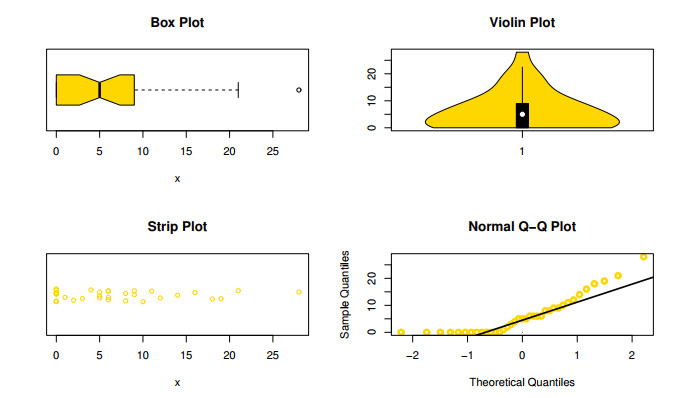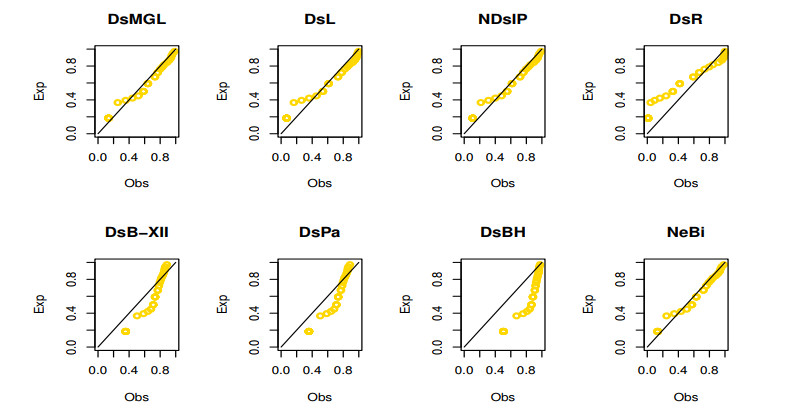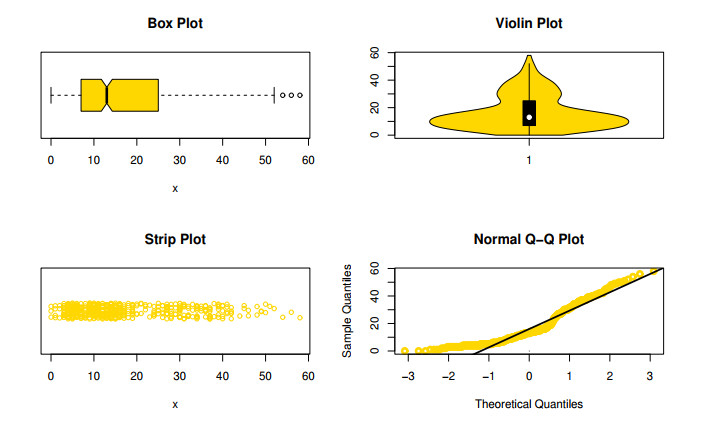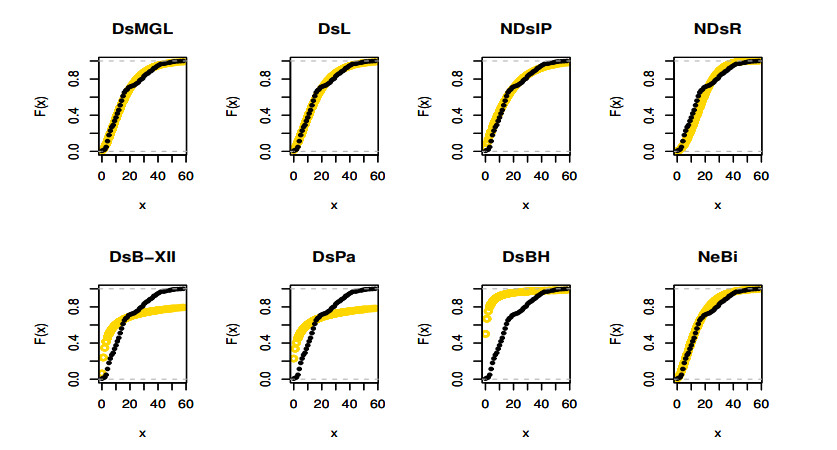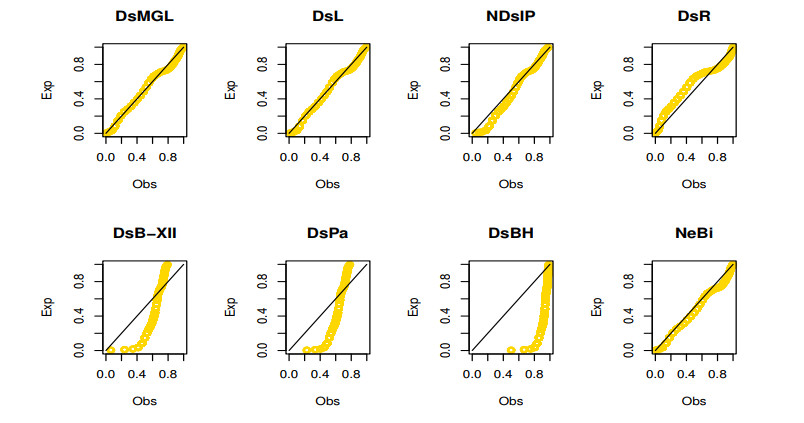1.
Introduction
The data generated by the daily work environment are more complex in nature at present, and therefore many lifetime models have been listed in the literature to analyze and evaluate these data. Determining which probability distribution should be adopted to make inferences from the data under study is a very important problem in statistics. For these reasons, great efforts have been spent over the years in developing large categories of distributions along with relevant statistical methodologies. See, for instance, El-Gohary et al. [1], Saboor et al. [2], Jia et al. [3], Fernandez [4], Alizadeh et al. [5], Kumar et al. [6], and references cited therein. Nedjar and Zeghdoudi [7] proposed a mixture of gamma(2,τ) and Lindley(ε) (MGL) distributions. The probability density function (PDF) of the MGL distribution can be expressed as
Unfortunately, Eq (1.1) is not a proper PDF. Messaadia and Zeghdoudi [8] corrected the parameter space to be ε≥τ1+τ and τ>0, and consequently the modified PDF of the MGL model can be written as
The survival function (SF) corresponding to Eq (1.2) can be formulated as
The quantile function (QF) is
where W−1 denotes the negative branch of the Lambert W function, and −ln(1−u)τ is the QF of the exponential model. Sometimes, survival trials produce data that are discrete in nature either because of the limitations of the measuring instruments or their inherent characteristics. The study and analysis of counting data plays an important role in many fields of applied sciences, such as economics, engineering, marketing, medicine, and insurance. Counting datasets are often modeled utilizing the Poisson model. However, the Poisson model cannot handle hyper-scattered datasets. Therefore, it is reasonable to model such cases via an appropriate discrete distribution. Discretization of a continuous distribution can be created by using several methods. The most widely utilized technique is the survival discretization approach. For a given continuous random variable X with SF S(x;ξ)=Pr(X>x), we can obtain the discretized version as
For more details, Roy [9]. This technique has received a lot of attention in recent years. See, for instance, Gómez-Déniz and Calderín-Ojeda [10], Bebbington et al. [11], Nekoukhou et al. [12], Alamatsaz et al. [13], El-Morshedy et al. [14], Gillariose et al. [15], Singh et al. [16,17], Eliwa and El-Morshedy [18], Altun et al. [19] and references cited therein. In this paper, a discrete distribution MGL (DsMGL) will be discussed from the point of view of reliability and ordered statistics theoretically and practically to analyze extreme and outliers' notes. This is because in El-Morshedy et al. [20], simple statistical characteristics and a regression model were presented only in a small whole sample (outliers were not included). Further, the previous paper ignored the reliability, order statistics, and L-moments measures which can be applied in the fields of biomedicine and engineering. Given the importance of reliability and structured statistical measures, the authors sought to discuss neglected characteristics as well as model extreme and outliers' observations. Thus, the motives for this study can be summarized as follows: to formulate statistical characteristics as closed forms; to model dispersed-positively-skewed real data under extreme and outliers' observations; to provide a consistently better fit than other discrete models known in the current statistical literature, especially over-dispersed models; and to prove that the proposed model can be applied to discuss zero-inflated observations.
The article is organized as follows. In Section 2, the DsMGL distribution is proposed. Various properties are derived in Sections 3 and 4. In Section 5, the DsMGL parameters are estimated by utilizing the maximum likelihood approach. Simulation study is discussed in Section 6. In Section 7, three real data sets are analyzed. Finally, some conclusions and future work are listed in Section 8.
2.
Discrete analogue of MGL distribution
Recall Eq (1.3), and the SF of the DsMGL distribution can be expressed as
where ε≥−lnδ1−lnδ, 0<e−τ=δ<1, and N0={0,1,2,3,...}. The corresponding PMF to Eq (2.1) can be introduced as
The CDF can be reported as
Figure 1 shows the PMF of the DsMGL model based on various values of the parameters ε and δ.
As can be noted, the PMF can take unimodal or decreasing form. Moreover, it can be used as a statistical approach to model zero-inflated observations under positive skew.
3.
Reliability analytics
In reliability theory, the forward iteration "remaining" time and the past time are two very important measurements in the theory of renewal processes. Consider, for example, the lifetime of a wireless link when a new packet arrives in wireless networks. Reliability studies model the remaining life of a component. If something has survived that far, how long can it be expected to survive? This is the question answered by mean residual life (MRL). In the discrete setting, the MRL, say Θi, is defined as
where N0={0,1,2,3,...,q} for 0<q<∞. Thus, for the DsMGL model, the MRL is given as
Furthermore, in the discrete setting, the mean past life (MPL), say Θ∗i, is defined as
So, the MPL for the DsMGL model can be represented as
For i∈N0, we get Θ∗i≤i. The CDF of the DsMGL model can be recovered by the MPL as
where F(0;ε,δ)=(q∏i=1[Θ∗iΘ∗i+1−1])−1and 0<q<∞. Thus, the mean of the DsMGL model can be expressed as
The reversed hazard rate function (RHRF) can be expressed as a function in MPL as
Further, the RHRF can be proposed as
Figure 2 shows the RHRF plots for different values of the DsMGL parameters.
Suppose W and H are two independent DsMGL random variables (RVs) with parameters (ε1,δ1) and (ε2,δ2), respectively. Then, the RHRF of T=min(W,H) and L=max(W,H) can be formulated as
and
Since the RHRFs of the two RVs W and H are decreasing, then the RHRFs of T=min(W,H) and L=max(W,H) are also decreasing. Another important measure in survival analysis theory is called the hazard rate function (HRF). If X is a DsMGL random variable, then the HRF can be expressed as
where h(x;ε,δ)=Px(x;ε,δ)S(x−1;ε,δ). Figure 3 shows the HRF plots for different values of the DsMGL parameters. It should be noted that the new paradigm can be used to discuss any phenomena of an increasing unilateral form.
Suppose W and H are two independent RVs with parameters DsMGL(ε1,δ2) and DsMGL(ε2,δ2), respectively. Then, the HRF of T=min(W,H) can be formulated as
where Λ=(ε1,ε2,δ1,δ2). Then,
Since the HRFs of the two RVs W and H are increasing, the HRF of T=min(W,H) is also increasing. Similarly, the HRF of L=max(W,H) can be expressed as
4.
Some distributive properties
4.1. The DsMGL distribution for order statistics: PMF and moments
Assume X1:l,X2:l,...,Xl:l are the corresponding order statistics (OS) of the random sample (RS) X1,X2,..., Xl from the DsMGL model. Then, the CDF of the ith OS is given as
where ϑ(l,b)(m)=(−1)j(lb)(l−bj). The corresponding PMF to Eq (4.1) can be listed as
where fi(x;ε,δ,b+j) represents the PMF of the exponentiated DsMGL distribution with power parameter b+j. So, the vth moments of Xi:l can be written as
Hosking [21] has defined the L-moment (L-MT) to show the descriptive statistics for the probability model. The L-MT of the DsMGL can be formulated as
Using Eq (4.4), L-MT of mean =Υ1, L-MT coefficient of variation =Υ2Υ1, L-MT coefficient of skewness =Υ3Υ2, and L-MT coefficient of kurtosis =Υ4Υ2.
4.2. The original moments for data behavior scan
The shape of any probability model can be described by its different moments. Based on the first four moments, the mean "E(X)", variance "Var(X)", index of dispersion "D(X)", skewness "Sk(X)", and kurtosis "Ku(X)" can be derived. Let X be a DsMGL random variable. Then, the probability generating function (PGF), say Υ(z), can be formulated as
where the power series converges absolutely at least for all complex numbers z with |z|≤1. Equation (4.5) can be derived utilizing the Maple software program. Thus, the first four moments of the DsMGL model can be listed as
and
According to the previous moments "E(Xr); r=1,2,3,4", the E(X), Var(X), Sk(X), and Ku(X) can be derived in closed forms. Table 1 reports some numerical results for the DsMGL model under different values of the distribution parameters.
The DsMGL is capable of modeling positively skewed and leptokurtic datasets. Further, it is appropriate for modeling under- (over-) dispersed phenomena where Var(X)|E(X)|<(>)1 for some parameter values.
5.
Estimation of the DsMGL parameters
In this segment, the maximum likelihood estimates (MLEs) of the model parameters are determined. Let X1,X2,...,Xn be a RS of size n from the DsMGL distribution. The log-likelihood function (LL) can be written as
The MLEs of the parameters ε and δ, say ˆε and ˆδ, are derived by (ˆε,ˆδ) = argmax(ε,δ) (L) or, in an equivalent approach in our case, (ˆε,ˆδ) = argmax(ε,δ) (LL). To provide more practicalities, the normal equations can be formulated as
and
The two previous equations cannot be solved analytically; therefore, a mathematical package such as the R program based on an iterative procedure such as the Newton-Raphson (numerical optimization approach) can be used to obtain the estimators.
6.
Simulation: Appreciative behavior of estimators
In this segment, Monte Carlo simulation was performed to prove the efficiency of the DsMGL model utilizing the maximum likelihood approach. The performance of the MLE with respect to sample size n is tested. The evaluation is based on a simulation study:
1) Generate 10000 samples of size n= 10,11,12,...,60 from the DsMGL model based on four cases as follows: case I: (δ=0.1 and ε=0.9), case II: (δ=0.3 and ε=0.9), case III: (δ=0.5 and ε=0.9), and case IV: (δ=0.7 and ε=0.9).
2) Generate 10000 samples of size n= 30,70,140,200,300,400,600 from the DsMGL model based on four cases as follows: case V: (δ=0.5 and ε=0.4), case VI: (δ=0.5 and ε=0.5), case VII: (δ=0.5 and ε=1.5), and case VIII: (δ=0.5 and ε=2.0).
3) Compute the MLEs for the 10000 samples, say ˆεj and ˆδj for j=1,2,3,...,1000.
4) Compute the biases, mean-squared errors (MSE), and mean relative errors (MRE).
5) The empirical results are shown in Figures 4–7 and Tables 2 and 3.
According to Figures 4–7 and Tables 2 and 3, the magnitude of bias, MSE, and MRE always decrease to zero as n grows (consistency property). Thus, the MLE approach can be utilized effectively for the parameter's estimation.
7.
Data modeling
In this section, we demonstrate the resilience of the DsMGL distribution in modeling COVID-19 data. Fitted models are compared using some criteria, namely, the −LL, Akaike-information-criterion (AIC), modified-AIC (MAIC), Hannan-Quinn-information-criterion (HQIC), Bayesian-information-criterion (BIC), and Kolmogorov-Smirnov (K-S) test with its corresponding P-value. We will compare the flexibility of the DsMGL model with some of the competitive models such as discrete Lindley (DsL), discrete Burr-Hatke (DsBH), new discrete distribution with one parameter (NDsIP) (see, Eliwa and El-Morshedy, 2022), discrete Rayleigh (DsR), discrete Pareto (DsPa), discrete Burr type XII (DsB-XII), and modified negative binomial (NeBi) models.
7.1. Data set I: COVID-19 in Hong Kong
The data is listed in (https://www.worldometers.info/coronavirus/country/china-hong-kong-sar/) and represents the daily new cases in Hong Kong for COVID-19 from Feb. 15, 2020, to Oct. 25, 2020. The initial shape/form of this data is reported in Figure 8 using non-parametric (N-P) methods like strip, box, violin and QQ plots. It is noted that there are extreme and outliers' observations.
The MLEs with their corresponding standard error (SE), confidence interval (C. I) for the parameter(s) and goodness-of-fit test (G-O-F-T) for COVID-19 data in Hong Kong, are listed in Tables 4 and 5.
The DsMGL model is the best among all the discussed models, because it has the lowest value among −LL, AIC, MAIC, BIC, HQIC and K-S. Moreover, the DsMGL model has the highest P-value among all tested distributions. Figures 9 and 10 show the estimated CDF and P-P plots for all reported models from which the distribution adequacy of the DsMGL model can be noted clearly. Thus, the COVID-19 data in Hong Kong plausibly came from the DsMGL model.
Table 6 lists some descriptive statistics (DEST) for COVID-19 data in Hong Kong utilizing the DsMGL model.
The data reported here suffer from excessive dispersion "D(X) > 1". Moreover, it is moderately right skewed "Sk(X)>0" and leptokurtic "Ku(X)>3".
7.2. Data set II: COVID-19 in Iraq
The data is reported in (https://www.worldometers.info/coronavirus/country/iraq/) and represents the daily new cases in Iraq for COVID-19 from Feb. 15, 2020, to 25 Oct. 25, 2020. In Figure 11, the N-P plots are sketched. It is noted that there is an extreme observation.
The MLEs with their corresponding SE, C. I for the parameter(s) and G-O-F-T for COVID-19 data in Iraq, are listed in Tables 7 and 8.
The DsMGL model is the best among all the studied models. Figures 12 and 13 show the estimated CDFs and P-P plots for COVID-19 data in Iraq.
From Figures 13 and 14, the data set plausibly came from the DsMGL model. Table 9 lists some information for COVID-19 data in Iraq based on the DsMGL model.
The data listed here suffer from excessive dispersion. Furthermore, it is moderately right skewed and leptokurtic.
7.3. Data set III: COVID-19 in Saudi Arabia
The data is reported in (https://en.wikipedia.org/wiki/2020_coronavirus_pandemic_in_Saudi_Arabia) and represents the daily new cases in Saudi Arabia for COVID-19 from March 1, 2020, to Sep. 13, 2021. In Figure 14, the N-P plots are reported. It is found that there are extreme observations.
The MLEs with their corresponding SE, C. I for the parameter(s) and G-O-F-T for COVID-19 data in Saudi Arabia are reported in Tables 10 and 11.
According to Table 10, the DsMGL model is the best among all the tested models. Figures 15 and 16 show the estimated CDFs and P-P plots for COVID-19 data in Saudi Arabia. It is found that the data set plausibly came from DsMGL model.
Table 12 lists some DEST around COVID-19 data in Saudi Arabia by utilizing the DsMGL model.
The data presented here suffer from excessive dispersion. Moreover, it is moderately right skewed and leptokurtic.
8.
Conclusions remarks and future works
In this article, we have developed a new two parameter discrete model, named as discrete mixture gamma-Lindley (DsMGL) distribution. Various important distributional characteristics of the DsMGL distribution have been discussed. One of the important virtues of this newly developed model is that it can not only discuss over-dispersed, under-dispersed, positively skewed, and leptokurtic data sets, but it can also be applied for modeling increasing failure time data (due to its increasing HRF). The unknown parameters of the DsMGL model have been discussed under a method of maximum likelihood (ML) estimation. A detailed MCMC evaluation has been conducted to measure the behavior of the estimators. This numerical study shows that the ML estimation measures work satisfactorily. Finally, the modeling flexibility of the DsMGL distribution has been explored via three real data sets on COVID-19. For future work, the authors will utilize the DsMGL model to generate a bivariate extension distribution based on a shock models approach for modeling bivariate data. Moreover, the first-order integer-valued regression model and autoregressive process will be studied in detail.
Acknowledgments
The authors gratefully acknowledge Qassim University, represented by the Deanship of Scientific Research, on the financial support for this research under the number (COS-2022-1-1-J-25173) during the academic year 1444 AH / 2022 AD.
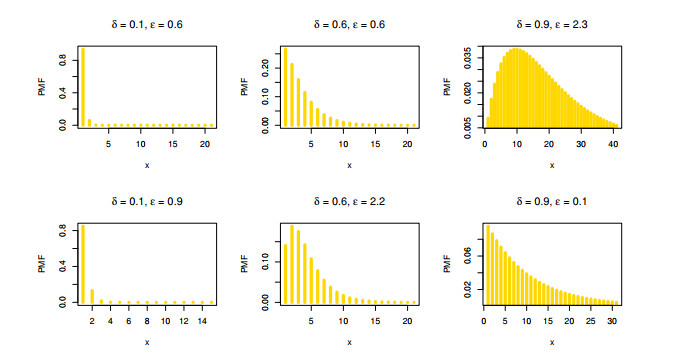









 DownLoad:
DownLoad:
